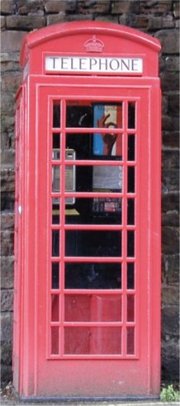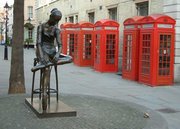Red telephone box
|
|


London_phone_box.jpg
The red telephone box, a public telephone kiosk designed by Sir Giles Gilbert Scott, was a once familiar sight on the streets of the United Kingdom. It has all but disappeared in recent years, replaced by a number of different designs. The few kiosks that remain have not been replaced because they are regarded as being of special architectural and historical interest.
The first standard public telephone kiosk introduced by the United Kingdom Post Office was produced by Somerville & Company in 1920 and was designated K1 (Kiosk no. 1). This design was not of the same family as the familiar red telephone boxes.
The red telephone box was the result of a competition in 1924 to design a new grander kiosk. The competition attracted designs from a number of noted architects. The Fine Arts Commission judged the competition and selected the design submitted by Sir Giles Gilbert Scott as the winner. The Post Office made a request that the material used for the design be changed from mild steel to cast iron, and that a slight modification be made to the door; after these changes, the design was designated K2. The kiosks were painted red was so that they might be easily recognised from a distance by a person in an emergency. In some rural areas the boxes were painted green so as not to disrupt the natural beauty of the surroundings.
From 1927 K2 was mainly deployed in and around London. K3 designed in 1930, again by Gilbert Scott was similar to K2 but was constructed from concrete and intended for rural areas. K4 (designed by the Post Office Engineering Department and proposed in 1923) incorporated a machine for buying postage stamps on the exterior. Only 50 kiosks of this design were built. K5 was a plywood construction introduced in 1934 and designed to be assembled and dismantled and used at exhibitions.
In 1935 K6 was designed to commemorate the silver jubilee of King George V. K6 was the first standard telephone kiosk to be used throughout the country. Many thousands of K6 boxes were deployed in virtually every town and city and it became a British icon. K6 telephone boxes eventually began to be replaced in large numbers in the early 1990s Thousands of old K6 kiosks were sold off at public auction. Some kiosks have been converted to be to used as shower cubicles in private homes. In Kingston upon Thames a number of old K6 boxes have been utilised to form a work of art resembling a row of fallen dominoes.
In 1959 architect Neville Conder was commissioned to design a new box. The K7 design went no further than the prototype stage. K8 introduced in 1968 was designed by Douglas Scott and Bruce Martin. It was the first box to replace K6 in significant numbers, and the last design be painted predominantly red.
Upon the privatisation of Post Office Telephone's successor, British Telecom (BT), the KX100, a more utilitarian design, replaced almost all the red boxes; a few remain, mainly in rural areas. The KX100 PLUS, introduced in 1996 featured a domed roof reminiscent of the familiar K2 and K6. Subsequent designs have departed significantly from the old style red telephone boxes.
In response to BT's plans to replace red boxes with more modern designs, several of the former have been listed.
